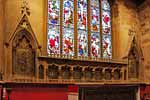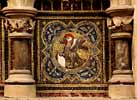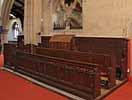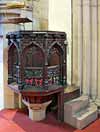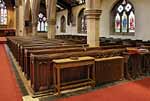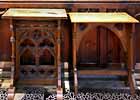For this church:    |
Mansfield St JohnFeatures and FittingsChancelAltar The symbols carved into the front panel of the altar are a vine, wheat, The Lamb of God, lillies and a Passion Flower. Reredos
The columns of the reredos are of Derbyshire marble. The stonework of the reredos was carved by Mr Gudgeon – a stonemason employed on the building of the viaducts carrying the L.M.S. Railway. The mosaics were given by Mrs. Brown during the period that Canon Bartlett was vicar (1866-1881). The two large panels depict the Archangels Gabriel and Michael; the small panels contain symbols of the Four Evangelists and monograms for Alpha, Omega and IHS. Choir Stalls
The clergy and choir stalls are a memorial to the Rev. William Marples, vicar of St John’s from 1883 to 1909. They were carved by Hunstone of Tideswell, Derbyshire. Drawings of the stalls by Advent Hunstone from 1927 are held in the church archives. The inscription reads:
Reader's deskA small brass plaque on the desk reads: 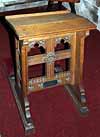
Bishop’s ChairThe Bishop’s Chair was given by Bob and Margaret Thompson:
Beatitudes Board
NavePulpit
Font There is also a portable font near the Lilley Altar; it is contained in a small wooden box with a brass plaque which reads:
Hymn BoardTo the right of chancel arch is a wooden hymn board with the following inscription on a small brass plaque:
Psalm Board
Pews and tables
In 1855 the church was fitted out with open benches made from stained deal, with accommodation for 1,000 people, with half the seats free in accordance with Gally Knight’s instructions. A small table in the nave has an inscription that reads:
Lectern
The Lilley ChapelThe altar in the Lilley Chapel was originally the high altar until it was moved and re-dedicated in 1926 to the memory of Rev. W. Lilley. There is a brass plaque on the south wall commemorating the Rev William Lilley. In the chapel there is a sculpture of two miners. The inscription states:
|



